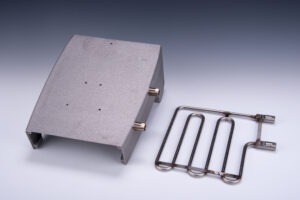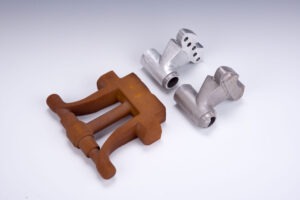In this podcast episode, we met with metal casting engineer Monty Fullerton to learn about 3 design opportunities for complex aluminum permanent mold castings: steel inserts, sand cores, and pull cores.
Cores and inserts are special design considerations that you can use to achieve more complex, customizable parts. All three options we discuss below can be used in permanent mold casting. They will be part of your tooling.
With aluminum casting, you can add steel inserts. First, the metal insert is placed in the mold. Then, the metal is poured into the mold and completely surrounds the insert. When the metal hardens, the insert and the casting become one. These metal inserts are tightly held in place, being extremely strong and functional.
For example, you can directly embed strong bearings, tubing, heating/cooling channels, and more into your product during the casting process.

A sand core is a one-time-use insert to create cavities, hollows, channels, passages in a casting. Sand cores are custom structures made of sand and a binder. Core makers use different recipes and ratios of binders depending on the sand core’s application. Creating a sand core is similar to creating a sand mold. Today, some sand cores are even 3D printed.
Before each pour, a sand core is placed in one half of the mold. The mold is closed, then molten metal is poured inside. The metal fills the empty space without penetrating the sand core. Then, the core is removed by shaking or heat treating.
Sand cores can be used in sand casting or permanent mold casting. When a sand core is used in permanent mold, it’s called semi-permanent mold casting.
Permanent mold casting is the low-turbulence, gravity-induced method of creating custom metal components with a reusable steel mold. Semi-permanent mold casting is exactly the same process, but with the addition of a non-reusable component: A sand core. This slight difference essentially combines permanent mold casting with sand casting.
When designing castings, it’s important to keep in mind the flexibility and opportunity that sand cores provide. However, keep in mind two things:
Therefore, we cannot cast a hollow ball.
Also, keep in mind that the internal sand surface finish of your casting will be lower quality than the steel-mold-given external surface.
Permanent mold can hold tight tolerances with and without sand cores.

Read more about this multi-cavity, semi-permanent mold casting made for the medical industry.
Pull cores are reusable inserts, built into your steel mold, and powered by the hydraulic system. They’re engaged before you pour, then slide out as the part hardens.
Pulls or slides are commonly used in die casting and permanent mold casting.
When designing for pulls, include generous draft to easily slide them out of the casting. At Batesville Products, our general rule of thumb is 3 degrees, but draft requirements vary based on the design.